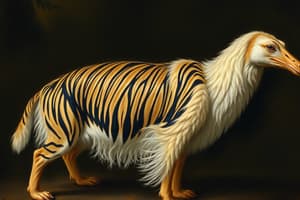Podcast
Questions and Answers
Which of the following are classes of vertebrates? (Select all that apply)
Which of the following are classes of vertebrates? (Select all that apply)
- Mollusca
- Reptilia (correct)
- Amphibia (correct)
- Agnatha (correct)
What are the four characteristics of Phylum Chordata?
What are the four characteristics of Phylum Chordata?
Notochord, dorsal hollow nerve cord, pharyngeal gill slits, postanal tail.
Which of the following are characteristics of Subphylum Vertebrata? (Select all that apply)
Which of the following are characteristics of Subphylum Vertebrata? (Select all that apply)
- Distinct head region (correct)
- No cranial protection
- Presence of vertebrae
- All chordate characteristics (correct)
Non-vertebrate chordates include the subphylum Urochordata.
Non-vertebrate chordates include the subphylum Urochordata.
What type of fish are classified as Agnatha?
What type of fish are classified as Agnatha?
Hagfish belong to the order ________.
Hagfish belong to the order ________.
What are two characteristics of lampreys?
What are two characteristics of lampreys?
Which of the following classes are jawed fish? (Select all that apply)
Which of the following classes are jawed fish? (Select all that apply)
What is the primary distinction of Subclass Elasmobranchii?
What is the primary distinction of Subclass Elasmobranchii?
What are the main characteristics of Subclass Holocephalia?
What are the main characteristics of Subclass Holocephalia?
What percentage of all vertebrate species are bony fish?
What percentage of all vertebrate species are bony fish?
Subclass Actinopterygii refers to ________ fishes.
Subclass Actinopterygii refers to ________ fishes.
Order Dipnoi includes lungfish.
Order Dipnoi includes lungfish.
What is unique about the reproductive method of order Actinistia?
What is unique about the reproductive method of order Actinistia?
Flashcards are hidden until you start studying
Study Notes
Classification of Vertebrates
- Seven vertebrate classes include Agnatha, Chondrichthyes, Osteichthyes, Amphibia, Reptilia, Aves, and Mammalia.
Phylum Chordata Characteristics
- Four key characteristics: notochord, dorsal hollow nerve cord, pharyngeal gill slits, and postanal tail.
Subphylum Vertebrata Features
- Contains all chordate characteristics along with a distinct head region and cranium for a large brain.
- Not all vertebrates possess vertebrae; Agnatha (jawless fish) is an example.
- Undergo more complex physiological processes compared to other chordates.
Non-Vertebrate Chordates
- Subphylum Urochordata includes tunicates and sea squirts.
- Subphylum Cephalochordata includes lancelets and amphioxus.
Class Agnatha
- Represents jaw-less fish, including hagfish and lampreys.
Hagfish Characteristics
- Belong to order Myxiniformes, family Myxinidae.
- Lack vertebrae, feature scale-less bodies, usually pink or purple.
- Primarily scavengers found in marine environments.
- Possess barbels for sensory perception due to poor eyesight.
- Produces large amounts of mucus as a defense mechanism.
Lampreys Characteristics
- Belong to order Petromyzontiformes, family Petromyzontidea.
- Can be either free-living or parasitic, posing threats to gamefish.
- Produce anticoagulants that keep host fish bleeding.
- Life cycle includes a freshwater larval stage lasting up to seven years before returning to the ocean as adults.
Class Chondrichthyes
- Comprised of jawed fish such as sharks, skates, rays, ratfish, and chimeras.
Subclass Elasmobranchii Features
- Contains 816 species including sharks, skates, and rays.
- Highly successful predators with unique reproductive strategies involving internal fertilization.
- Characterized by torpedo-shaped bodies and no swim bladder.
- Equipped with exceptional sensory abilities for hunting.
Subclass Holocephalia Features
- Contains 34 species often referred to as "complete head" fish.
- Includes ratfish or chimeras, which have distinctive features like large eyes and buck teeth.
- Found in deep marine environments, these fish feed on sea urchins and shrimp.
Class Osteichthyes
- Known as bony fish, comprising 50% of all vertebrate species.
- Divided into lobe-finned and ray-finned fish.
Subclass Sarcopterygii Characteristics
- Lobe-finned fish characterized by fleshy, lobe-like fins.
- Ancestors of amphibians, featuring swim bladders and operculum-covered gills.
Order Actinistia Features
- Contains 25 species, including the coelacanth, known as a living fossil.
- Species have changed little over the past 70 million years, prefer deep marine habitats.
- Exhibit nocturnal predation habits and use fins for locomotion on the ocean floor.
Order Dipnoi Features
- Consists of 65 species known as lungfish, which can breathe air via modified swim bladders.
- Lay eggs with external fertilization and can burrow in mud during dry periods, entering a state of dormancy.
Subclass Actinopterygii Characteristics
- Encompasses ray-finned fishes, divided into non-teleosts and teleosts.
- Teleosts represent the majority, showcasing incredible diversity and advancements in jaw mobility compared to non-teleosts.
Studying That Suits You
Use AI to generate personalized quizzes and flashcards to suit your learning preferences.




